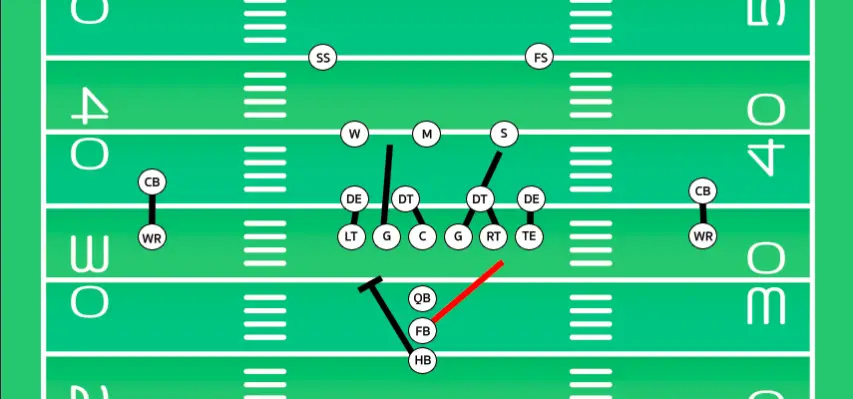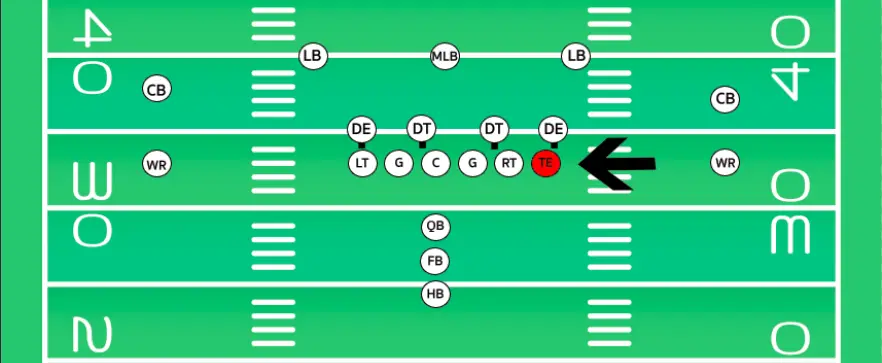A tight end in football is an offensive position that is responsible for catching the football as well as blocking defenders. Tights ends tend to split their time between running routes and blocking tacklers on running plays.
Tight ends are typically one of the taller and stronger positions on the field. Though they need to stay at a relatively low weight due to the athleticism they need in the receiving game.
Tight ends are essentially a mix between offensive lineman and wide receivers. They have a build somewhere in between the two and utilize both skill sets of blocking and receiving though usually not to the ability of receivers or lineman.
What does a tight end do in football?
As we stated earlier the tight end is a position that has multiple duties on offense.
In football, there are three things a tight end has to do. Catch passes from the quarterback, block defenders on rushing plays, and protect the quarterback on some passing plays.
Some tight ends will excel in blocking while others are primarily used for catching the football.
Tight ends can be instrumental when rushing the football as they will often be blocking on the side of the field the ball is run towards.
Receiving passes as a tight end
Receiving is a huge aspect of being a tight end. The best tight ends in the NFL are used almost exclusively for their receiving skills instead of their blocking.
If a tight end receiving skills are elite at this position they can be as dangerous as a number one receiver.
This has especially been the case recently as tight ends like Travis Kelce and George Kittle have put up incredible receiving stats as tight ends in recent years.
Blocking on rushing and passing plays

In order to be a complete tight end you are going to need to block well. Tight ends are often blocking just as much as they run routes. Tight ends that don’t excel at receiving are likely to be used for blocking the majority of the time.
One reason tight ends are crucial blockers is because of how they line up. Tight ends tend to line up on the line of scrimmage at the end of the formation. This results in their end of the formation having one more player.
This means more runs in this direction, when this happens the tight end is often the lead blocker as it is his block the running back has to get around.
Tight End Attributes
In order to be to play the tight end position successfully players are going to need to have several important attributes. Strength, hands, and football IQ are three attributes we are going to cover in this guide.
Strength
This attribute is a fairly self-explanatory feature of being a tight end. Unfortunately, there is just no way to play this position if you do not possess the physical strength to block defenders.
This is why the tight end is a position that is typically reserved for larger stronger players.
Hands
Being sure-handed is one of the most important factors of being a tight end. Let’s face it tight ends aren’t going to make circus catches or juke out any defenders. For this reason, they need to have the basics down pat.
Furthermore, a tight end is a position that is not going to get a lot of targets per game. This means if they throw them the ball they better catch it. To be effective, making the most of their limited offensive opportunities is a must.
Football IQ
Football IQ is an attribute that could benefit just about any position, but tight end especially. The most effective time to utilize football IQ at this position is when running routes.
Tight ends typically run shorter routes and often make their living by finding holes in zone coverage.
A truly great tight end always finds a way to get open right when his quarterback needs him. Tight ends like Heath Miller or Jason Witten are examples of players that lack physical attributes but used their IQ to remain successful at the position.
Build
Tight end is one of the tallest and largest positions in the sport. The height of tight ends is higher than any other position except for the offensive line.
When it comes to weight tight ends are only behind the defensive and the offensive line. This makes them one of the largest positions in the sport.
If you are wanting to play this position you will have to not only be tall, but thick as well.
Positioning

On the majority of plays, you will find that the tight end will line up at the end of the formation. This usually leaves the formation lopsided as one side of the line will have one more player than the other.
This is called the strong side and is almost always the side where the tight end is. The strong side is going to affect how the defense lines up as well. Some defense have a strongside and a weakside linebacker.
Meaning the strongside linebacker will line up on the same side as the tight end. While the weak side linebacker will line up on the other side.
This position typically lines up off the line of scrimmage. Meaning there is usually a wide receiver that is outside him, lined up on the line of scrimmage.
Concluding Thoughts
We hope this guide has taught you everything you need to know about this position. If you have any more questions don’t hesitate to reach out and let us know.
Remember the tight end position is a combination of an offensive lineman and a wide receiver. These players catch passes from the QB but also are effective blockers on passing and rushing plays.

